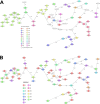Colonization with resistant bacteria in hospital employees: an epidemiological surveillance and typing study
- PMID: 39324817
- PMCID: PMC11539204
- DOI: 10.1128/aac.00985-24
Colonization with resistant bacteria in hospital employees: an epidemiological surveillance and typing study
Abstract
The objective of this study was to determine the prevalence, molecular epidemiology, and risk factors for gut colonization with extended-spectrum β-lactamase-producing Enterobacterales (ESBL-E), carbapenemase-producing Enterobacterales (CPE), and vancomycin-resistant enterococci (VRE) in healthcare workers (HCWs). In September/October 2022, we performed a cross-sectional study among HCW from 14 institutions in Northeastern Switzerland. HCWs reported risk factors for antimicrobial resistance (covering the last 12-24 months) and provided rectal swabs. Swabs were screened for ESBL-E, CPE, and VRE; whole-genome sequencing (WGS) was performed to assess the genetic relatedness. Logistic regression was used to identify occupational and non-occupational risk factors. Among approximately 22,500 employees, 1,209 participated (median age 46 years, 82% female). Prevalences of ESBL-E (n = 65) and CPE (n = 1) were 5.4% [95% confidence interval (CI) 4.2-6.8] and 0.1% (95% CI 0.0-0.5), respectively; no VREs were detected. In the multivariable analysis, non-European ethnicity [adjusted odds ratio (aOR) 7.0, 95% CI 1.4-27.3], travel to high-risk countries (aOR 4.9, 95% CI 2.5-9.3), systemic antibiotics (aOR 2.1, 95% CI 1.1-3.7), antibiotic eye drops (aOR 4.7, 95% CI 1.7-11.9), and monthly sushi consumption (aOR 2.4, 95% CI 1.4-4.3) were positively associated with ESBL-E colonization, whereas alcohol consumption (aOR 0.5 per glass/week, 95% CI 0.3-0.9) was negatively associated with ESBL-E colonization. Occupational factors showed no association. Among ESBL-Escherichia coli, ST131 (15 of 61, 25%) and blaCTX-M-15 (37/61; 61%) were most common; one isolate co-harbored blaOXA-244. WGS data did not show relevant clustering. Occupational exposure is not associated with ESBL-E colonization in HCW. Given the potential public health and antibiotic stewardship implications, the role of sushi consumption and antibiotic eye drops as risk factors should be further elucidated.
Keywords: ESBL; antibiotic resistance; colonization; epidemiology; healthcare workers; occupation; prevalence; risk factors; sushi.
Conflict of interest statement
The authors declare no conflict of interest.
Figures



References
-
- Fulchini R, Albrich WC, Kronenberg A, Egli A, Kahlert CR, Schlegel M, Kohler P. 2019. Antibiotic-resistant pathogens in different patient settings and identification of surveillance gaps in Switzerland - a systematic review. Epidemiol Infect 147:e259. doi:10.1017/S0950268819001523 - DOI - PMC - PubMed
Publication types
MeSH terms
Substances
Grants and funding
LinkOut - more resources
Full Text Sources
Research Materials
Miscellaneous

